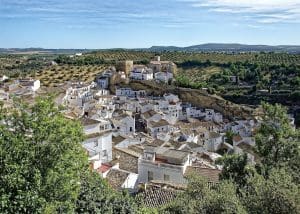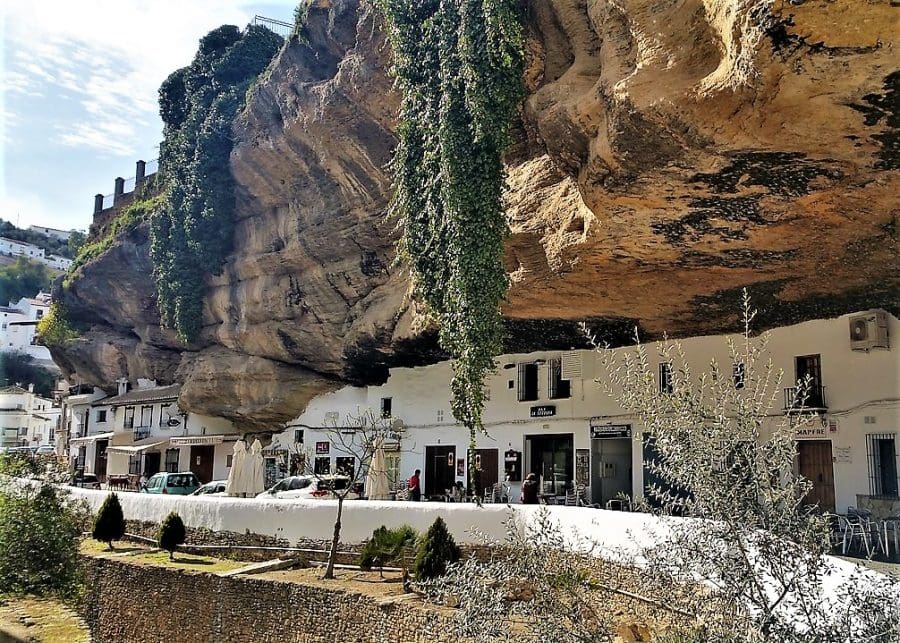For an altogether different “white village” experience, head for Setenil de las Bodegas on the “Ruta de los Pueblos Blancos” in the Sierra de Cádiz. Home to only 3,000 people, you’ll notice the absence of streets ‘polished’ for the tourist. But first and foremost you’ll be astounded by the entrance to this unique and scintillating village.
Yes, the houses in Setenil de las Bodegas – without exception small in stature – are whitewashed. What you can see of them, at least. For the most part, only the facade, part of the sidewalls and a roof section neatly covered with tiles are visible. The rest are buried in the sandstone cliffs that form the village. These are not cave houses like in Gaudix, but “abrigo rocas”, which literally translates as “rock shelter”.
Unusual surprise hidden in a river gorge
The houses seem to be glued to the almost perpendicular cliffs. And the wall of the river gorge looks more like a strange flat where the rock only started to hang over after its construction was completed. It’s clear this unique village owes its existence to the river Guadalporcún. The river flows right through the village, and whose hunger river devoured the bottom of the gorge for many centuries. The gorge reaches a depth of up to fifty metres in some places.
From the upper street at the entrance of the village, a green string of deciduous trees contrasts with the white of the houses and the grey of the roof tiles below. On the other side of the river, a few tables are comfortably arranged under a huge piece of sloping stone. Although for someone with claustrophobic tendencies, consuming a tapa there may not be a good idea.
Casco antiguo
Park your car immediately after entering Setenil de las Bodegas as the streets are so narrow. Even the smallest cars fold the mirrors in order to drive through them unscathed. From Plaza de Andalucía, where the post office and two cosy-looking restaurants are located, head to the historic part of Setenil, or ‘casco antiguo’; also called ‘La Villa’ by the Setenileños.
A tunnel of houses leads from restaurant “El Mirador” to a somewhat shabby-looking street. Broad steps connect houses with chipped facades in faded colours. Grubby stray dogs fit in perfectly with the somewhat tired décor. Furthermore, at the end of the semi-circular street is a partially open stable where horses stand around looking for something edible. Plaza Andalucía is a friendly little square that had the bad luck to be tiled with shiny “bathroom tiles” in the Andalucian colours of green and white.
‘Warts and all’ experience
Crisscrossing the streets, the view changes with every step. Descend to the river, cross a bridge, and before you is a tropical terrace. Arches covered with deep green subtropical plant species ask you to walk underneath and see what lies beyond. The riverbank, washed with brown water and with more than a passing semblance to an emptied rubbish bin, is a somewhat disappointing discovery. But that is what makes Setenil different, it’s a ‘warts and all’ experience. The picturesque facades of the houses on the river can mask the disappointment a little.
‘Soap street’
It seems impossible to live in Setenil if you are taller than 1.60 metres, the houses are that tiny. Calle Jabonera (“soap street”) is a verbal reminder that women used to wash their clothes here in days gone by. Seen from here, the fort is impressive. Via a long stairway, you will reach a square at the top of the gorge and from here you’ll be able to find your bearings. There is a beautiful church and countless nice corners, each with different interesting details. Lots of houses sit above and next to each other with hardly any living space in between. Tiny balconies seem stuck directly to the rock and some of the houses cannot be more than half a metre deep. The gorge walls are dotted with plants or cacti which grow on the small plateaus.
Seven times nothing
Setenil de las Bodegas does appear to be on the decline with many houses for sale. Glimpse into a renovated home and you’ll be shocked by just how small they are – only enough room for a sofa and table. However, Setenil was once a very prosperous village due to its location on the “Ruta del Viajero” (traveller’s route) between Ronda and Osuna. All trade passed through the hidden village between the 18th and 19th centuries.
Step back further in time and you’ll find Setenil’s reconquest by the Christians during the Catholic King’s battle for Granada was a pivotal moment. From the time of Juan II of Castillia (around 1402) to that of Los Reyes Católicos (around 1480), seven attempts were made to conquer the village before the Christians finally succeeded on September 21, 1484. This is immortalised in the name of the village, which appears to be derived from the Latin “septem nil” which means “seven times nothing.”
The addition of “de las bodegas” (from the wine cellars) dates to the time when there were many vineyards in the area. This wealth ended abruptly as a result of an insect infestation in 1860. Nowadays, the inhabitants mainly live off the production of chorizo, broad beans, cereals, olive oil, and tourism.

Things to see
Setenil has many monuments if you want more than just a taste of the atmosphere. Part of the twelfth-century fortress is the well-preserved Torre del Homenaje. At the foot of the robust building is a well-preserved ‘aljibe’ (water reservoir) dating from the same time. The view from the tower’s mirador covers most of the village.
The Oficina de Turismo is in a special building with huge wooden doors and a beautifully decorated – also made of wood – ‘artesonado ceiling’. The Iglesia Nuestra Señora de la Encarnacion has neo-Gothic frescoes.
Legend has it, Queen Isabel (one of the Catholic Kings) lost her newborn son, Sebastian, in Setenil. A church called San Sebastian was built on the site after the conquest and San Sebastian has been the patron saint of the village ever since.
Two streets in Setenil de las Bodegas are unique: the “Cueva del Sol” and the “Cueva de la Sombra”. The first has its name because of its sunnier location on the south; logically there is always shade in the “Cueva de la Sombra”. Here the rock wall protrudes so far that it forms a street tunnel with the houses below. Inside, the ceilings seem black with soot from the centuries of fires that have been lit there. In the summer, it is a good place to stay because of the coolness that reigns there and, vice versa, the immense rock also provides insulation in the cold winters.
More information about Setenil de las Bodegas:
www.setenildelasbodegas.es: information from and about the municipality
www.setenil.com: information from the Oficina de Turismo
Oficina de Turismo, Calle Villa, 2
Tel: 956 134 261/659 546 626
Email: turismo@setenil.com


